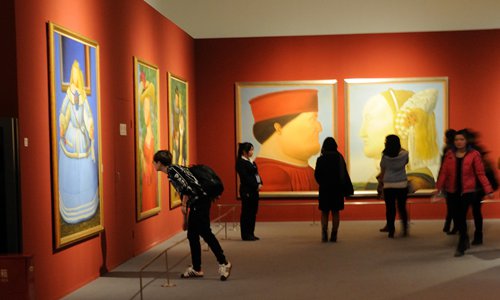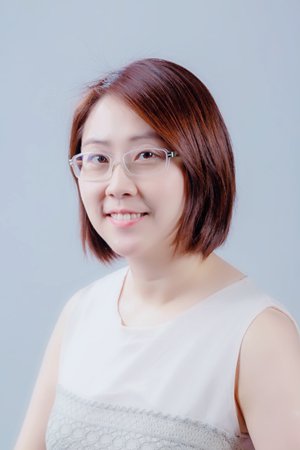HOME >> ARTS
Beijing-based Hong Kong curator reflects on the choices that brought her to the capital
By Tao Mingyang Source:Global Times Published: 2019/8/19 18:00:07

Visitors explore the Botero in China art exhibition at the National Museum of China in Beijing on November 27, 2015. Photo: IC

Janet Fong Photo: Courtesy of Janet Fong
As an art exhibition curator, Janet Fong often finds herself visiting various art museums and exhibitions around the world. However, at the end of the day, there is nowhere she'd rather be than in the capital of China: Beijing.
Born and raised in China's Hong Kong, Fong moved to Beijing 12 years ago looking for more opportunities to grow and learn that she wasn't able to find at home. During her time in the capital over the past decade, she has seen numerous changes take place in the city, as well as in herself.
Pursuing art
Fong majored in photography in university. After graduation, she joined a photography exhibition institute sponsored by the Hong Kong Arts Development Council in 1997.
"Two years after graduation, I felt I had learned all I could [in Hong Kong]," Fong told the Global Times.
"So I then went to the University of Sydney and got a postgraduate diploma in museology."
Returning to her home city in 2000, Fong started her curatorial work at the University Museum and Art Gallery of The University of Hong Kong.
Finding herself running up again another wall of learning a few years later, Fong decided to head to the UK for further study.
"I got my master degree in art history in the UK and returned to Hong Kong in 2003 to work in the area of modern art," said Fong.
"That was a field I had always been interested in."
Fong told the Global Times that she helped establish several museums and art museums at that time, including helping found the Hong Kong Maritime Museum.
"I was in charge of collecting items for display, planning the museum layout and communicating with the artists," said Fong.
"I wasn't very familiar with maritime history so I kind of stumbled my way through, but it turned out to be quiet a success when all was said and done. Even the city's chief executive attended the opening ceremony."
After working in Hong Kong for about three years, Fong had the opportunity through the local Osage Gallery to head to Beijing for an art exhibition.
"I met many active Beijing artists during the exhibition. Modern art was beginning to bloom in China from 2006 to 2009," said Fong.
"I've lived in many places around the world and I think Beijing is very much like New York as it gathers people from different places together."
Fong felt that the diversity and opportunities in Beijing suited her perfectly, so she decide to "give it a go" in the capital.
Discovering differences
"Twelve years ago, I thought everything in Beijing and Hong Kong was the same," said Fong.
"But when I started to live and work in Beijing, I realized the two places are totally different."
"In Hong Kong, we usually have a very clear divide between our work and personal lives," said Fong.
"We have a meeting first to discuss work, then go for a lunch. During lunch, we don't talk about work."
When Fong first arrived in Beijing, she had dinner with her work partner. Before their dishes were served, they had already worked out the details for the exhibition.
"I was very confused about why they wanted to discuss our cooperation at dinner, but then gradually realized that's how people communicate here," said Fong.
Fong's husband is from the mainland and their daughter was born and raised in the mainland. Fong has also noticed the differences between families in the Chinese mainland and Hong Kong.
"I remember winter several years ago, the air pollution was heavy and I got the flu due to the bad air," said Fong.
She told her parents-in-law and her child to wear a mask at home so they wouldn't become infected.
"Because they are too weak to resist the virus, I didn't want them to get a fever," said Fong.
Fong said they were not willing to wear masks at home but agreed to it in the end.
"But they would take off their masks when eating lunch and eat together just the same as always," said Fong.
Unfortunately, everyone in the family caught the flu.
"But it made me realized that affection among family members is more important than lives when it comes to mainlanders," said Fong.
'Empty 155 years'
"Hong Kong is a super fast paced city, almost everyone around me was a workaholic," said Fong, "but I was always busier."
Fong joked that during her time at the Osage Gallery in Hong Kong, she was "hollowed out" by her job. At her busiest, she was in charge of nine exhibitions at three separate art museums.
"I could only sleep for two hours a day for half a month," Fong said.
After moving to Beijing, Fong found the pace of life far more suitable.
"Now I have my own exhibition platform, so I don't to find a full-time job," said Fong.
"I now have more time to read books or spend time with my family."
This difference made her realize that a gap exists between Hongkongers and people in the mainland.
"Hong Kong was colonized for 155 years," said Fong. "They [The British] erased local arts, education, politics and the concept of a nation."
"In many Hongkongers' mind, right and wrong are clearly divided, but in traditional Chinese culture yin and yang are mixed together," said Fong.
"Just like a coin has two sides."
Fong, however, does think things are changing. Although Hong Kong returned to China only a little over two decades ago, Fong feels that the gap created by that "empty 155 years" is narrowing quickly.
Newspaper headline: Narrowing the gap
Posted in: ART,ARTS FOCUS